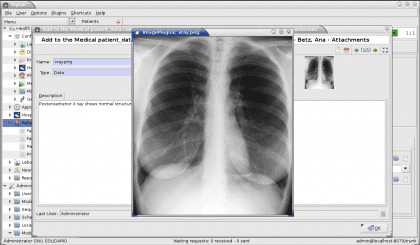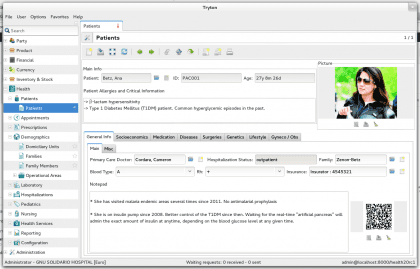GNUHealth is a system created under the profile of use of FOSS, which is intended manage hospital information or of health centers, for the creation of clinical records, or as an information system and record of the activities carried out in said centers. This system is price quotation and it can be used for a small clinic or health center, thanks to its versatility and multiplatform capacity, as well as for a health center of greater capacity.
GNUHealth has been developed by thymbra, company with experience in the areas of administration, medical informatics and ERP (Enterprise Resource Planning) based on FOSS. In 2011 Thymbra makes GNU Health a part GNU Solidarity, a non-profit organization in charge of expanding free software as a measure to seek equality in access to this system, promoting GNU Health as a project that promotes improvements in medical information, offering benefits to patients and health professionals .
According to the needs of the center or institution, GNU Health offers the following modules within the system:
- Health: Main and global data of everything related to patients and the health center.
- History: Record of the patient's clinical history and follow-up of the same.
- Calendar: Appointment control calendar for health professionals.
- Inpatient: Control of patient hospitalization.
- Surgery: Surgery and surgical check-ups.
- Services: Billing for patient services.
- Lifestyle: Lifestyle recommendations for and for the patient.
- Nursing: Management of nursing services.
- Lab: Laboratory management and all its services.
- Genetics: Genetics, Traits, and Hereditary Risks.
- Socioeconomics: Socioeconomic statistics and data.
- Pediatrics: Specialized module for pediatrics.
- Gynecology: Specialized module for gynecology and obstetrics.
- QR codes: Module for generating and storing QR codes for labeling.
- MDG 6: Millennium Development Goals 6, initiative proposed by the WHO to combat HIV / AIDS, malaria and other diseases.
- Reporting: Automated generation of reports, graphs and epidemiological statistics.
- ICU: Management for intensive care unit.
- Stock: Administration of the warehouse of medical supplies of the health center.
- NTD: Support for Neglected Tropical Diseases.
- Imaging: Medical imaging and order management.
- ICPM: International Classification of Procedures in Medicine.
- Crypto: Use of the GNU Privacy Guard and support for documents or validation of records.
Each GNU Health module can be customized according to the needs of the health center, that is, each one is independent, in addition they do not have restrictions with respect to the operating system. In the main module, those modules that are considered relevant or necessary in the main view can be modified or added.
GNU Health is based on Triton, a business management software, with a platform that manages data registration, oriented for the administration of various types of businesses; ranging within its functionality from the registration of counterparties (customers or distributors) to records at the accounting or billing level, project monitoring, sales and purchasing management, and MRP (Manufacturing Resource Planning).
The language behind GNU Health is Python. Language widely used within programming developments and with a large community that supports it, so we constantly see developers and health professionals making contributions for this suite of tools.
Natively, GNU Health is coupled with PostgreSQL, for the administration of the database. Maintaining the usage profile of FOSS. In this way its functionality is guaranteed in operating systems such as Windows, Solaris, Mac OS X, Linux, among others.
GNU Health is already used in several countries worldwide. Being a great option as a public health system, thanks to the fact that it is completely free and adaptable to different health centers. And although its creator Luis Falcon, began as a project for the prevention of diseases and health campaigns, today it has evolved to be a fairly complete system for the administration of health centers, facilitating their work to the personnel of these institutions. The idea lies not only in improving the information registration system, but also in giving access to an optimal system for all communities that need it.





Very interesting article, could you tell me how to install it on Debian8. Regards.
Thanks for your comments Oscar.
First you must click on «Download» on the following link http://health.gnu.org/es/download.html. Then, unzip the file, position yourself in the directory and run ./gnuhealth_install.sh or bash gnuhealth_install.sh.
If you need additional support, do not hesitate to contact us!
Thank you for your prompt response, I have a daughter who is a doctor and I showed her the article, as she found the application very interesting and I downloaded it and sent it to her, she will study it, I will send you any questions. Regards.
No longer need tryton for installation?
Run on Tryton. The project installer takes care of everything.
https://es.wikibooks.org/wiki/GNU_Health/Gu%C3%ADa_T%C3%A9cnica
Very good system! It is the one we are using for an outreach project in our faculty, and we implement it in a few care centers in the area.
We have already reached out and added our own modules.
The framework on which it runs is very good too.
regards
Excellent, Francisco. Congratulations, keep helping others with your projects.
We hope you can share your experiences with us in more detail.
Regards!
With pleasure. We have a group on fb called public health chair, where we share this and other activities.
You are invited to visit it.
regards
Thanks for such a good article, I think that to support it you have to first try it and then recommend it… Thank you very much….
Excellent article and excellent software, my question is how to install it in windows operating system, since when downloading the application the installers have the extension sh gnuhealth_install.sh, to be able to implement it.
thanks ..
Jose Luis, for windows you have Neso, which is a standalone, or the client for said OS. Now, if you want to use it on a network, I recommend doing it from a server that runs GNU / Linux, which is where the Tryton framework is mounted.
The installer you mention is for GNU / Linux.
Any questions you have, drop a message.
regards
I want to know how to install it please
If you would be so kind to support me
Hello Daniel. Every so often I enter the note, because for some reason notifications do not reach me.
In the gnuhealth wiki you have a step by step on how to install it. I recommend you take a day, very calm, read it completely, and get down to work.
It is not difficult, but it is difficult and uphill. Haha
https://es.wikibooks.org/wiki/GNU_Health/Gu%C3%ADa_T%C3%A9cnica
You can also install it with pip (python repository manager), where you install trytond and the modules you need. It is advisable to first define what type of environment you are going to use: production or development.
An image that we made with Ubuntu and we have in Mega will also serve you there:
https://mega.nz/#F!j8hD0BqY!KtW78fDjJ-rDTwGLSBlHkQ
Greetings and that it is useful to you (beyond the delay in the response)
Francisco
how do i install it on mac? Thanks in advance for the answer
Hello Dr Murillo,
Installing the graphical client can be done on Mac. But that's half the story.
What you will need, yes or yes, is a Linux machine, which is where the server is installed.
This machine is either a physical computer or a virtual machine, which can run on Mac. I have not worked on mac environments, so I could not tell you which virtual machine managers are recommended.
regards
thanks for the information but can you tell me how to install in Windows 10
As a medical student, this makes me happy 😀